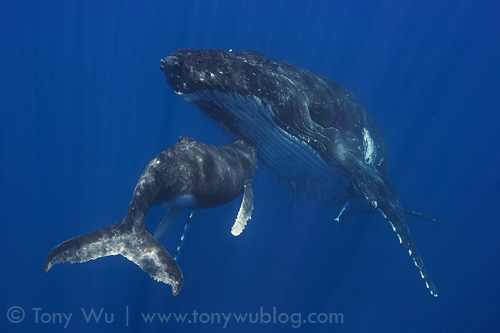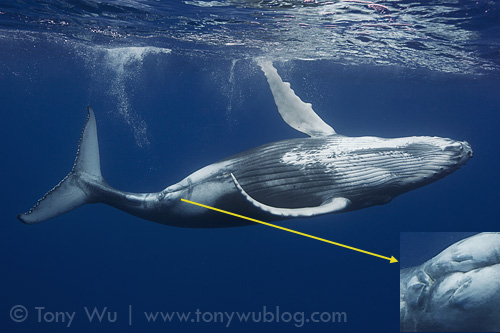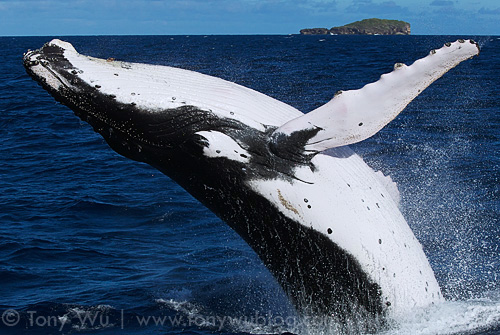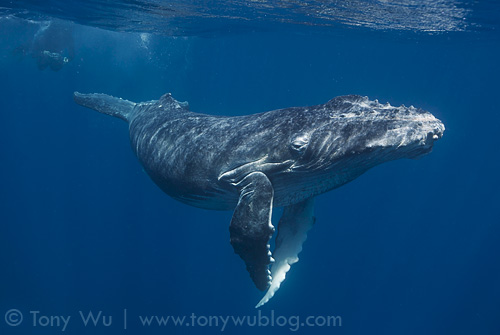The past week has been a good one. The weather has been mostly cooperative, with a predominance of sunshine, only one day that was overcast and drizzly. We photographed and identified three new humpback whale mother/ calf pairs...bringing the total count for the season to 12 pairs. And we photographed a bunch of breaching, including White Pec #7 for the season.

Motherly love: Humpback whale female with 12th ID-ed calf of the season
Humpback Whale Calf Count
My annual count of humpback whale mother/ calf pairs in the Vava’u area reached 12 this week, with three new babies added to the list.
For comparison, the count last year by this same date was 19 ID-ed calves. 2011 was, however, an extraordinary season, with a bumper crop of 48 ID-ed babies in all, so 12 isn’t bad by any stretch of the imagination.
To put this in context, the ID-ed mother/ calf pair counts by this date in 2008, 2009, and 2010 were 4, 10 and 10.
It’s important to keep in mind that these figures don’t represent an apples-to-apples (or is that whales-to-whales?) comparison. I didn’t start the counts on the same day each season, and I don’t have the same number of boats helping each season.
At the end of each season, when I have all the data, I try to normalise the calf count with a figure I calculate by dividing the total baby tally by the total number of boat days spent at sea looking for them.
Though this is still not a perfect measure, it is perhaps a better standard by which to compare each season. I obviously won’t have this figure until after this season is wrapped up, but for reference, the figures were 0.44, 0.27 and 0.59 in 2009, 2010 and 2011, respectively.
These ratios give a much better indication of frequency (or rarity) of encounters with mother/ calf pairs.
One other interesting observation during the week...all three baby whales ID-ed this week were females.

Calf #12 (female) playing at the surface,
with close-up showing developing mammary glands.
The apparent abundance of female calves is consistent with my observations from past seasons, with the female-to-male ratio among calves being 1.56, 1.75, 1.30 in 2009, 2010 and 2011, respectively, i.e., more female than male babies each season. Of course, since I can’t determine the sex of every calf, these figures are just indicative
As I’ve mentioned in the past, the apparent prevalence of female over male babies could be due to any number of factors: There could actually be more female calves than male babies; it’s possible that mother/ calf pairs with females tend to be more accommodating toward interactions with people; or...it could just be sheer coincidence. Who knows?
If this year’s calf count once again follows this trend though, my confidence in this tendency will certainly increase.
For more background on my annual calf count + observations and speculations, see my humpback whale calf count PDF file from last year.
White Pec #7
Yesterday, we saw our 7th white pec for this season!
It was one of several whales breaching, slapping and generally having a good time southeast of the Fatumanga area. Having to choose among whales is a good predicament to have, but we stuck with a particular pair because they seemed to enjoy showing off (approaching the boat and breaching all around us), and also because of the white pec. I really wanted to get a good photo of this particular whale, which fortunately was the one that seemed to breach the most.
As I mentioned in my first update, there seems to be a concentration of whales with all-white pectoral fins this season. All-white pecs are relatively more common in the northern hemisphere than among the humpback whales in the south, so it’s pretty easy to pick them out from the crowd, so to speak.
Once again, this is just continued speculation on my part, but the fact that there appears to be a cluster of this obvious phenotypical trait this season suggests to me that there could be an underlying genetic closeness among a subset of the whales in the Vava’u area right now. In other words, I’m wondering whether some of the whales here might be closely related to one another, given the appearance of this trait among so many whales.
The last time this trait appeared with such a relatively high frequency was 2006. And in other seasons, other obvious physical traits (ones different from all-white pec fins) have appeared in similar clusters.
I’ve read some papers suggesting that humpback whales do not travel in related groups as many toothed whales are known to do. But this then begs the question - Why would a concentration of whales with all-white pectoral fins show up in 2006 and 2012, but not in intervening or preceding seasons?

7th humpback whale of the season with all-white pectoral fins
Behaviour
A couple of seasons ago in 2010, I characterised the “mood” of the whales that year as “unsettled”. Most of the experienced people I spoke with here at the time concurred that the whales seemed somewhat on edge, relatively difficult to approach. Last year was different, with lots of whales around, and “normal” interactions, if I had to pick one adjective.
It’s still early in my stay here for the 2012 season, but to date, it seems like the whales are behaving in the “normal” to “friendly” range. We did have a few mother/ calf pairs yesterday that were not particularly cooperative, but that is the case every season. We just leave those alone.
Most of our interactions so far have been with extremely accepting whales.
Of interest to me, this overall “mood” (for lack of a better word) is consistent with my experience in 2006, the last time there were a number of whales with all-white pectoral fins around.
Once again, this could be pure coincidence, but it’s another data point in my ongoing observation of humpback whale behaviour in this area. Something else to ponder.

Calf #9 of the 2012 season, a friendly little girl